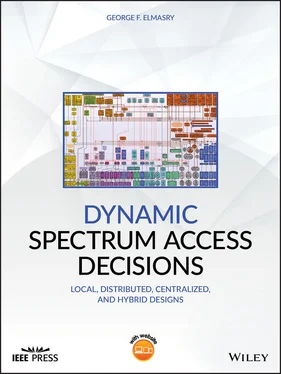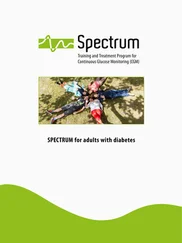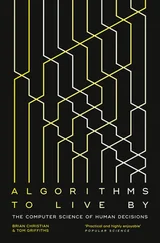5 Chowdhury, K. and Akyildiz, I., A routing protocol for cognitive radio ad hoc networks. IEEE Journal on Selected Areas in Communications, vol. 29, no. 4, April 2011.
6 Elmasry, G., Aanderud, B., and Arganbright, T., A distributed multi‐tiered network agent for heterogeneous MANET resource optimization. Proceedings of Milcom 2015.
7 Elmasry, G., Haan, B., and McCabe, R., Augmenting OLSR with a priority aware dynamic routing for hetergeneous netwoking. Proceedings of Milcom 2015.
8 Elmasry, G., Aanderud, B., Kraus, W., and McCabe, R., Software‐defined dynamic power‐control and directional‐reuse protocol for TDMA radios. Proceedings of Milcom 2015.
9 Jawar, I. and Wu, J., Resource Allocation in Wireless Networks Using Directional Antennas. Proceedings of PerCom 2006.
10 Kanzaki, A., Uemukai, T., Hara, T., and Nishio, S., Dynamic TDMA slot assignment in ad hoc networks. In Advanced Information Networking and Applications, March 2003.
11 Patil, V.C., Biradar, R.V., Mudholkar, R.R., and Sawant, S., On‐demand multipath routing protocols for mobile ad hoc networks issues and comparison. International Journal of Wireless Communication and Simulation, vol. 2(1), pp. 21–38, 2010.
12 Pearlman, M., Haas, Z., Sholander, P., and Tabrizi, S.S., Alternative path routing in mobile ad hoc networks. Proceedings of Milcom 2002.
13 Vergados, D.J., Koutsogiannaki, M., Vergados, D.D., and Loumos, V., Enhanced end‐to‐end TDMA for wireless ad‐hoc networks. IEEE Communications Conference, Computers and Communications, July 2007.
14 Wang, J., Kong, L., and Wu, M.‐Y., Capacity of wireless ad hoc networks using practical directional antennas. Proceedings of WCNC 2010, pp. 1–6.
15 Young, C.D., USAP: a unifying dynamic distributed multichannel TDMA slot assignment protocol. IEEE Military Communications Conference, MILCOM 1996, October 1996.
16 Zhang, J. and Liew, S.C., Capacity improvement of wireless ad hoc networks with directional antennae. SIGMOBILE Mobile Computing and Communications Review, vol. 10, no. 4, pp. 17–19, October 2006.
17 https://tools.ietf.org/html/draft-ietf-manet-dlep-02.
18 https://tools.ietf.org/id/draft-dubois-r2cp-00.txt.
19 https://tools.ietf.org/id/draft-ietf-manet-dlep-16.txt.
20 https://tools.ietf.org/rfc/rfc5578.txt.
1 1 Another case for using the simple ROC model is with MANET spatial frequency reuse. The spectrum sensor is sensing (probing) a frequency used by a peer node and the goal of spectrum fusion is to decide if the frequency can be spatially reused or not at a given geolocation and time without interfering with the other peer node.
2 2Similar to all aspects of network design, DSA design will require simulation environment and laboratory testing during the system design and evaluation phases and before deployment. Hidden nodes can be simulated in scripted scenarios to evaluate the performance of this trade space
3 3 In Figure 4.2, for the same‐channel in‐band sensing case, noise and interfering signal are combined as noise.
4 4 This can occur in sensor networks where the node has SWaP limitations.
5 20 Notice in Figure 4.2that RSSI is a single‐dimension positive value. The figure shows three different scenarios of RSSI reading and the vertical line is meant to show the decision threshold not a vertical axis.
6 5 Some reference terminology is that a node has a single cognitive engine that contains multiple cognitive processes. Some other reference terminology is that a node has multiple cognitive engines. Regardless of using either terminology, a cognitive DSA engine/process has to work with other cognitive engines/processes.
7 6 This example makes a good case for developing DSA as a set of cloud services as further discussed in the second part of the book. One can see how in this example the routing engine is requesting a service (to establish a link) and the DSA engine is replying to the service request.
8 7 There are different propagation models the DSA engine can use, including a standard Gaussian model, a modified Gaussian model, a Lorentzian model or a modified Lorentzian model.
9 8 In heterogeneous hierarchical MANET, one can create two tears of routing: local routing within a network and global routing between networks.
10 9A flow can be dictated by source and destination address, and type‐of‐service (TOS), with the lowest amount of data rate allocation common between all waveforms.
11 10 One possible change that must not be ignored and needs to be considered first is power control. Node mobility may require increasing or decreasing power level while keeping all established links and routes unchanged. It will be left to the cognitive engines to decide if this change can be maintained or new links need to be established. Another similar change is directionality. The ability to keep the same topology with minimal changes to the beam direction should be explored and used before making changes that will affect route stability.
12 11 Many military communications waveforms use adaptive FEC. Some waveforms use concatenating codes where both the inner and outer codes are adaptive. The inner code can be turbo code while the outer codes can be RS code with erasure.
13 12 The reader should keep in mind the different control loop time periods. Routing within the network, which can be waveform dependent, can have its own techniques that create and tear down reactive routes separate from global routes. Global routes need to be more stable than routes local to a network.
14 13 It is important to see that with this architecture there could be two distinct types of cooperative distributed DSA. One type is distributed cooperative DSA between nodes within a single network. The other type is the global distributed cooperative DSA between the gateways.
15 14 This proxy can go both ways. With a large‐scale deployment of heterogeneous MANETs, some MANET gateways may not be able to reach the centralized arbitrator due to factors such as terrain. The gateways can proxy the centralized arbitrator decisions through the cooperative distributed approach described in the previous section.
16 15The distributed cooperative protocol from the previous section is now partially implemented to reduce control traffic volume because it is only a fallback solution. Messages from a gateway node to the centralized arbitrator can use an unreliable multicast protocol. Dissemination of all these messages to all gateways is not needed. The fallback distributed cooperative solution can fuse the subset of information that reaches the gateway through multicast messages.
17 16 Gaming theory based approaches can be used in the absence of a centralized arbitrator and some networks master DSA engines negotiating spectrum resources allocation with peer master DSA engines can be “greedy” in negotiation (overestimating date rate) causing the gaming theory based technique to tend to evenly distribute spectrum resources between the networks.
18 17 As explained earlier, making global routes stable is more important than making routes local to one network stable.
19 18 The system's requirements can define the maximum bandwidth that can be allocated to DSA control traffic.
20 19 The DARPA 100G program and the DARPA mobile hotspot program explored the adaptation of some 5G technologies for military communications use from two different aspects.
Part II Case Studies
Chapter 5 DSA as a Set of Cloud Services
The literature shows how different wireless communications systems study DSA from different angles. One can find many references on dynamic spectrum management for 5G cellular systems. The next chapter covers 5G dynamics spectrum management as one example of DSA systems. There are also cognitive radio references that look at DSA from the angle of opportunistic spectrum use and military‐focused DSA references that are built on the military concepts of operations covered in Part 3 of this book. The previous chapters explained many DSA concepts from the cognitive MANET perspective. This chapter looks at DSA without having any specific system or application in mind. This chapter is a case study where the case is generic. DSA is presented as a collection of cloud services that can be accessed on any hierarchal entity 1of a hierarchy of heterogeneous networks and DSA services are made available wherever and whenever they are needed. 2As the reader moves to the next chapter, 5G dynamic spectrum management may be viewed as a specific case study that can be derived from the generic representation of DSA as a set of cloud services presented in this chapter.
Читать дальше












